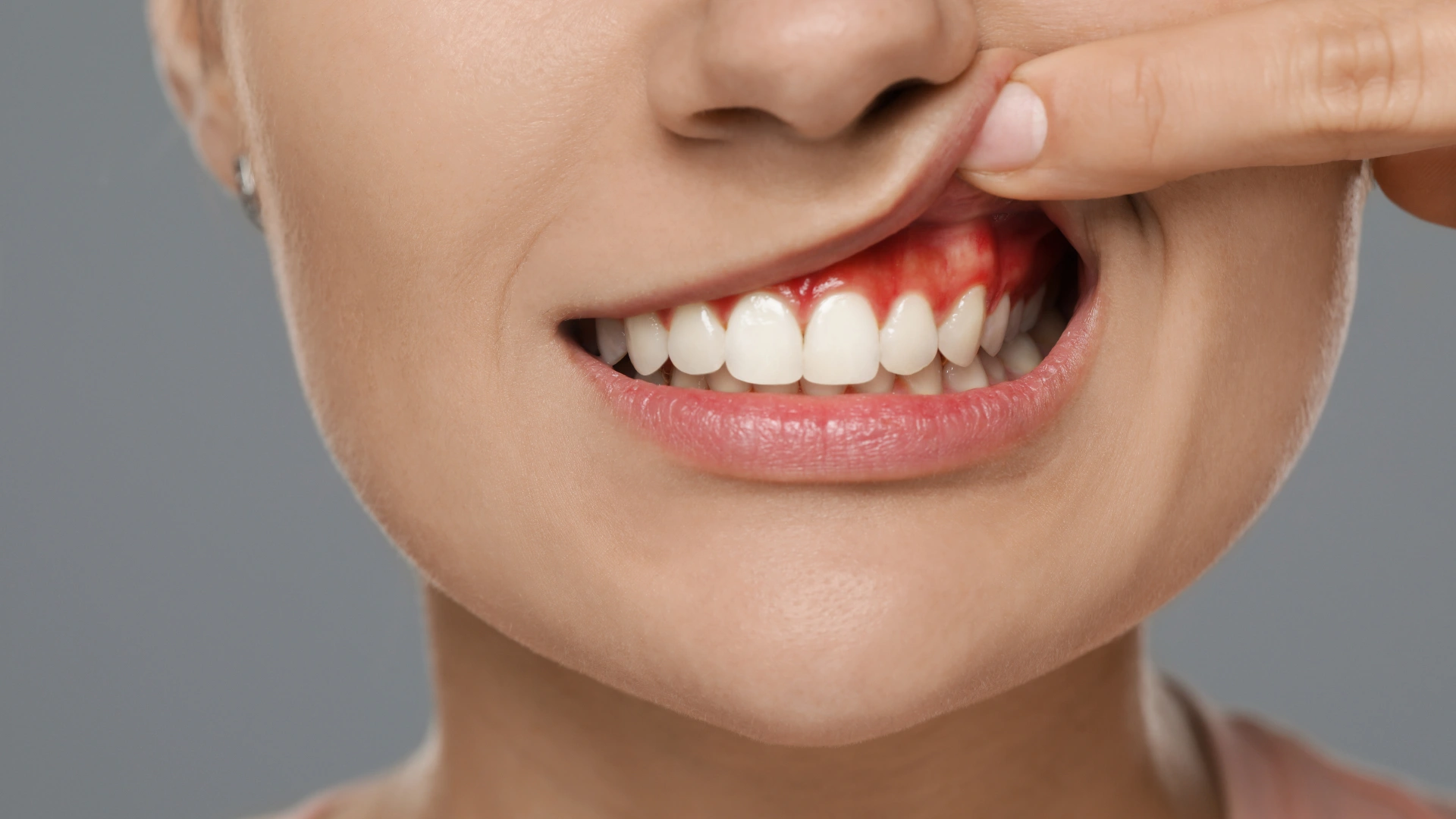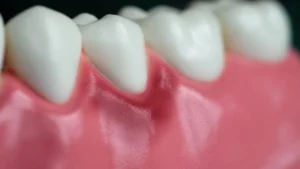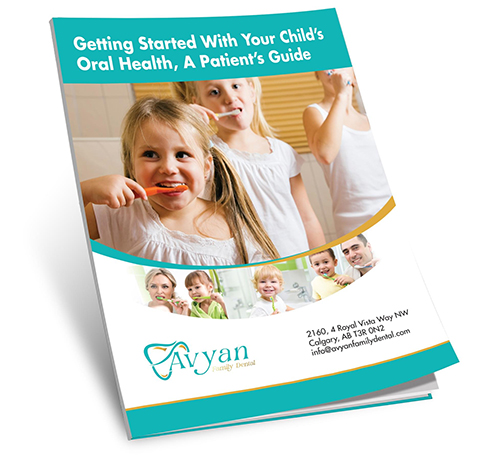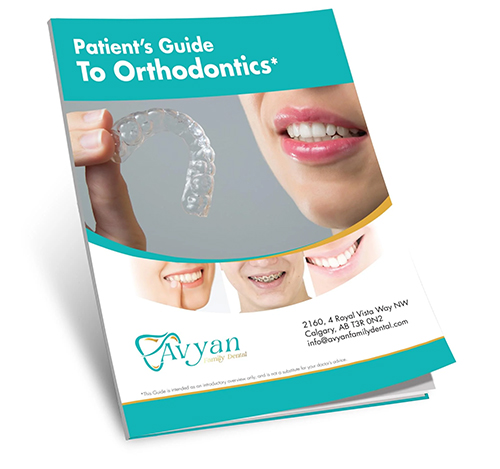Gingivitis is a common but serious gum disease caused mainly by plaque buildup, leading to swelling, redness, and bleeding gums. Left untreated, it can escalate into more severe oral health issues. Here, we’ll guide you through its causes, early symptoms, prevention tips, and treatment options so you can keep your gums healthy. We’ll help you understand our top six proven ways to stop gingivitis and gum disease from spreading in your home from our trusted family dentist in NW Calgary.
Key Takeaways
- Gingivitis is a common form of gum disease characterized by inflammation of the gums, primarily due to bacterial plaque accumulation, and can progress to more serious conditions if untreated.
- Maintaining rigorous oral hygiene practices, including regular brushing, flossing, and dental checkups, is essential for preventing and reversing gingivitis.
- Untreated gingivitis can lead to advanced periodontal disease, which poses significant dental and systemic health risks, including potential cardiovascular issues.
Understanding Gingivitis
Gingivitis is a condition marked by inflammation of the gums and is commonly referred to as gum disease or periodontal disease. It primarily involves the inflammation of the gum tissue, bones, and supporting tissues. This inflammation is often the result of a bacterial infection, making gingivitis a form of gum disease that requires attention.
Gingivitis is classified into two main categories: dental biofilm-induced and non-dental biofilm-induced. The former is caused by the accumulation of bacterial plaque on the teeth and gums, while the latter can result from various factors, including genetic disorders and specific infections. Despite being an early and mild form of gum disease, gingivitis should not be underestimated as it can progress to more serious conditions if neglected.
Understanding gingivitis is the first step toward prevention and treatment. With proper oral hygiene and regular dental care from a trusted family dentist in Royal Oak, Calgary, gingivitis can be reversed before it leads to more severe gum issues. Recognizing the symptoms and understanding the causes allows for proactive measures to maintain oral health for you and your family.
Causes of Gingivitis
The primary cause of gingivitis is inadequate oral hygiene, which allows dental plaque to accumulate. This plaque buildup near the gums is the most common cause of periodontal disease or gum disease. Poor oral hygiene practices, such as infrequent brushing and flossing, can lead to increased plaque accumulation, which in turn causes gum inflammation.
Reducing sugar intake helps prevent gum disease or periodontal disease by minimizing the risk of plaque buildup.
Plaque-Induced Gingivitis
Plaque-induced gingivitis is triggered by the accumulation of dental plaque, a biofilm formed by harmful bacteria on the teeth and gums if not removed through proper oral hygiene. These bacteria produce toxins that can damage gum tissue and contribute to gum disease. If left unchecked, this condition can progress, allowing bacteria to enter the bloodstream and potentially leading to systemic infections.
The key to preventing plaque-induced gingivitis is maintaining good oral hygiene. Regular tooth brushing, flossing, and professional dental cleanings help remove dental plaque and prevent the inflammation of the gums. Consistently removing dental plaque reduces the risk of serious gum diseases and protects overall health.
Hormonal Changes
Hormonal changes, particularly during pregnancy and puberty, can lead to an exaggerated inflammatory response in the gums, resulting in hormonal gingivitis. These hormonal fluctuations increase blood flow to the gums, making them more susceptible to inflammation and affecting the immune response.
Heightened oral care from our family dentist in Tuscany, Calgary during these periods can mitigate the risk of developing gingivitis.
Symptoms of Gingivitis
Gingivitis is characterized by irritation, redness, swelling, and bleeding gums surrounding the base of the teeth. Common gingivitis symptoms include bad breath, tender gums, a swollen gum line, and bleeding or irritated gums.
Early recognition of these symptoms from a trusted dentist in Glacier Ridge, Calgary is key to preventing permanent damage and reversing gingivitis.
Early Signs
Initial signs and symptoms of gingivitis include gums that appear swollen and exhibit colour changes to bright or dark red. Puffy gums and gingival pigmentation, along with blood in the sink when brushing, are typical indicators.
Identifying these early stages signs is crucial for effective treatment and prevention of more severe gum diseases.
Advanced Symptoms
Advanced symptoms of gingivitis include persistent bad breath and receding gums. Severe symptoms can also manifest as noticeable gum recession and persistent halitosis (bad breath).
Promptly addressing these symptoms can prevent progression to more serious conditions such as periodontitis.
Prevention Strategies
Preventing gingivitis involves maintaining a consistent oral hygiene routine. Regular brushing teeth, flossing, and professional dental cleanings are effective prevention strategies.
Good oral hygiene practices can prevent or even reverse gingivitis. Here we’ll review the top three prevention strategies, followed by the top three strategies to treat gingivitis.
1 – Daily Oral Care
Brushing with fluoride toothpaste at least twice a day helps maintain gum health. Using dental floss daily helps remove debris between teeth that brushing might miss. Brushing after meals, flossing, and rinsing with antiseptic mouthwash twice daily can help combat early-stage gum disease.
Regular brushing and flossing help remove plaque that can lead to gum inflammation. Adhering to these practices significantly lowers the risk of gingivitis and maintains good oral hygiene.
2 – Regular Dental Checkups
Regular dental cleanings and checkups are advised for maintaining oral health and preventing gingivitis. Our dental hygienists perform professional dental cleanings that help eliminate tartar buildup that regular brushing cannot remove. Dental professionals recommend these practices for optimal care.
Regularly scheduled dental checkups are crucial for effectively preventing gum disease and can help to prevent periodontal disease when you visit the dentist regularly.
3 – Healthy Diet
A diet low in sugar and rich in nutrients supports gum health and can help prevent gingivitis. Poor nutrition can negatively affect the health of gums and increase the likelihood of nutritional gingivitis.
Fruits and vegetables in your diet contribute positively to gum health.
Treatment Options
Various treatments for gingivitis can include professional teeth cleanings, deep dental cleanings, and surgical interventions. The primary objective is to reduce inflammation by removing dental plaque deposits. Next, we’ll review our top three treatment options to treat gingivitis symptoms.
1 – Professional Cleaning
Regular visits to the dentist are essential for professional dental cleanings that remove plaque build-up and prevent gum disease. Professional dental cleanings eliminate tartar buildup that regular brushing can’t remove.
2 – Scaling and Root Planing
Scaling and root planing target plaque and tartar accumulation both above and below the gum-line. These procedures remove deep-seated plaque and tartar that regular cleaning can’t address.
3 – Surgical Treatments
Surgical options for advanced gum disease may include flap surgery, which involves lifting the gums to access and clean the roots of the teeth.
Additional surgical options might include bone grafting and guided tissue regeneration. To learn more about dental surgery treatment options, please visit our dentist in Rocky Ridge, Calgary.
Risk Factors
Several factors can increase the risk of developing gingivitis, including smoking, genetic factors, and certain health conditions like diabetes. Awareness of these risk factors helps you and your family take preventive measures.
Lifestyle Factors
According to the Mayo Clinic, older adults are more susceptible to gingivitis due to changes in their oral health. Smoking and tobacco use significantly heighten the risk of developing gingivitis.
Health Conditions
Diabetes significantly increases the incidence or progression of periodontal disease if not managed properly. Conditions like rheumatoid arthritis can intensify the severity of gum disease by affecting the body’s inflammatory response.
Complications of Untreated Gingivitis
Failing to treat gingivitis can result in progressive gum disease that leads to significant tissue loss. Untreated gingivitis can progress to more advanced periodontitis, leading to severe gum and bone damage.
Periodontitis
Gingivitis is often seen as a mild form of periodontal disease that can escalate to more severe gum issues if untreated. Periodontitis is an advanced form of gum disease characterized by the deterioration of the bone and tissues supporting the teeth. As periodontitis advances, it can lead to loose teeth due to weakened support structures, potentially resulting in more serious gum disease and gingival diseases.
Early care increases the chances of reversing damage from periodontitis. Addressing gingivitis treated early prevents its progression to periodontitis and helps avoid severe consequences.
Systemic Health Risks
Untreated gingivitis can increase the risk of stroke and cardiovascular diseases. There is a recognized correlation between periodontal disease and increased risks of systemic diseases like heart disease, as highlighted in clinical periodontology.
Periodontitis is linked to various systemic health issues such as respiratory disease, rheumatoid arthritis, coronary artery disease, preterm birth, low birth weight, diabetes, and chronic inflammatory disease.
Summary
In summary, gingivitis is a preventable and treatable condition if caught early. Maintaining good oral hygiene, regular dental cleanings and checkups, and a healthy diet are key strategies to prevent and manage gingivitis. Early intervention can prevent the progression to more severe gum diseases like periodontitis, protecting both your oral and overall health.
To learn more about how to prevent gingivitis and gum disease, please contact Avyan Family Dental to book your appointment.
Frequently Asked Questions
Can you catch gingivitis from someone?
Gingivitis can be spread through the transmission of oral bacteria via saliva, primarily through mouth-to-mouth contact. This means that it is possible to catch gingivitis from someone else through activities that involve sharing saliva, such as kissing. However, maintaining good oral hygiene and avoiding sharing utensils or other items that come into contact with saliva can help reduce the risk of catching gingivitis from others. If you notice symptoms like swollen or bleeding gums, it’s important to seek dental care promptly.
How do you stop gingivitis from spreading?
To stop gingivitis from spreading, the key is maintaining excellent oral hygiene and seeking timely professional care. Here are proven steps to prevent its spread:
- Brush your teeth at least twice a day using fluoride toothpaste to remove dental plaque effectively.
- Floss daily to clean between teeth where a toothbrush cannot reach, removing plaque and food debris.
- Rinse with an antiseptic mouthwash twice daily to reduce bacteria in the oral cavity.
- Avoid sharing utensils, toothbrushes, or engaging in mouth-to-mouth contact that can transmit oral bacteria.
- Schedule regular dental checkups and professional cleanings to remove tartar buildup and monitor gum health.
- Address any early symptoms promptly by visiting a dentist for assessment and treatment.
By following these steps consistently, you can prevent gingivitis from progressing and spreading, protecting both your oral and overall health.
How to treat gingivitis at home?
Key steps include brushing your teeth at least twice a day with fluoride toothpaste, flossing daily to remove plaque between teeth, and rinsing with an antiseptic mouthwash twice daily. Additionally, incorporating brushing after meals can further help combat early-stage gum disease. These routine changes help remove dental plaque, reduce gum inflammation, and can effectively prevent or even reverse gingivitis if caught early. Regular dental cleanings and checkups are also important to support home care and ensure professional removal of tartar that cannot be removed by brushing alone.
What are some symptoms of gingivitis?
The primary symptoms of gingivitis are swollen and bleeding gums, bad breath, and changes in the fit of teeth or dentures. If you experience these symptoms, it is advisable to seek dental care promptly. Other signs may include puffy gums that appear red or purple, tenderness when brushing or flossing, and the presence of periodontal pockets—spaces that form between the gums and teeth due to inflammation. Early detection through periodontal probing by our dental professionals can help identify gingivitis before it progresses to more severe forms of periodontal disease. Untreated gingivitis can lead to chronic periodontitis, which involves bone loss and can eventually cause tooth loss. Maintaining good oral hygiene and receiving regular professional dental cleanings are crucial to reversing gingivitis and preventing further complications.
What should you do if you experience symptoms of gingivitis?
If you experience symptoms of gingivitis, it is essential to visit a trusted dentist in Arbour Lake, Calgary for a thorough assessment and appropriate treatment. Prompt attention can prevent the condition from worsening.






